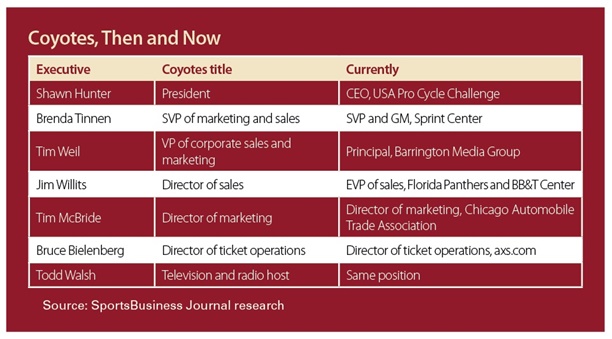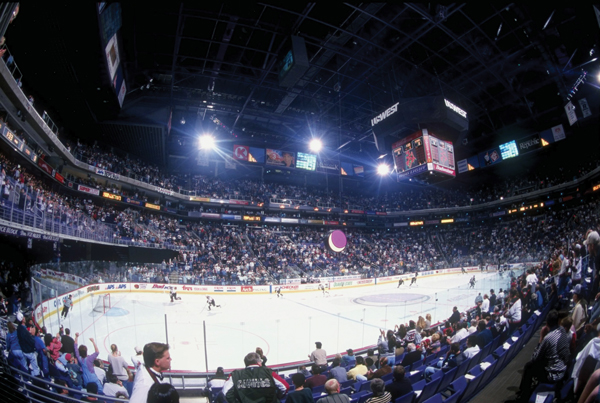 |
The hockey configuration at America West Arena, shown in 1998, created a north end (above left goal) full of limited-view seats for the then-Phoenix Coyotes to sell.
Photo by: GETTY IMAGES
|
An eerie feeling crept over Jim Willits as he approached the south end of Barclays Center.
It was mid-December and Willits, the Florida Panthers’ executive vice president of sales, was in Brooklyn for the team’s game against the New York Islanders. Before him he saw multiple sections of limited-view seats in a basketball arena retrofitted for hockey.
Willits immediately recognized the setup from his days with the original Phoenix Coyotes.
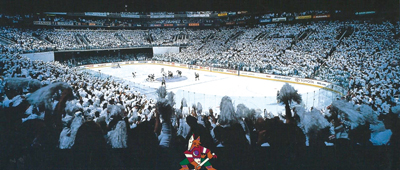 |
A view across the ice to the Bud Light Ice Block, under the seats in the north end. The enclosed space was the loudest spot in the arena.
Photo by: COURTESY OF BRUCE BIELENBERG
|
“I got over to that side and thought, ‘Oh, my God, this is exactly what we went through with the Coyotes,’” said Willits, that team’s director of sales from 1997 to 2002. “I almost started having convulsions.”
Twenty years ago, the Winnipeg Jets moved to Arizona and played their first 7 1/2 seasons at America West Arena, a venue built for basketball that had thousands of limited-view seats at one end when laid out for hockey. It was less than a perfect fit, but Willits, who’s quick with a joke about those early years, and an ambitious Coyotes ticket sales crew made the best of it. They even had fun with it.
It’s easy to forget their initial success in downtown Phoenix after the Coyotes’ financial woes of the past decade, but there was a time when they consistently played to full houses in a city excited by its first taste of hockey. On the ice, the Coyotes were a tough, physical bunch led by Jeremy Roenick, Keith Tkachuk and goalie Nikolai Khabibulin, and they became the hottest ticket in town, producing 69 sellouts over their first four seasons and playing to 94 percent capacity. They made the playoffs all four years.
“I was stoked, growing up in Minnesota as a big hockey fan and, on top of that, being in the desert with the warm weather,” said Bruce Bielenberg, the Coyotes’ former director of ticket operations.
Shawn Hunter, the Coyotes’ president from January 1996 until the summer of 2002, said, “We had a young but very talented staff that worked their tails off. The team was good and the market responded.”
But as the sales staff discovered before the Coyotes ever took the ice, some of those seats would be trickier to sell than others, especially in the pre-Internet age, when sales were made over the phone and at the ticket window.
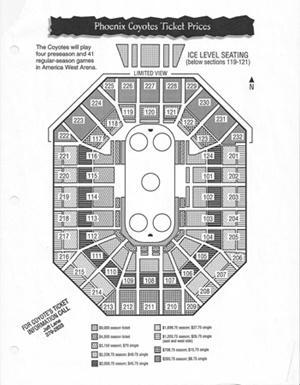 |
An early Coyotes seating chart shows the extent of the limited-view seats in the north end of America West Arena.
Photo by: COURTESY OF BRUCE BIELENBERG
|
In February 1996, Hunter hired his first Coyotes employee, Brenda Tinnen, from the Houston Rockets to be senior vice president of marketing and sales. They had both worked for the Minnesota Timberwolves in the early 1990s.
One week after Tinnen arrived in Phoenix, Hunter left town to get married and temporarily put her in charge of the operation. On his way out the door, Tinnen recalls, Hunter told her, “Oh, by the way, there are a few obstructed-view seats behind one goal.”
While Hunter was gone, Tinnen conducted a test to find out what he was talking about. She walked the north end and developed seating maps taking into account the arena’s retrofit for hockey. Ultimately, the total came to 5,287 seats, including some on both sidelines in addition to the north end, that did not have a full view of the ice and both goals. In an arena seating 16,210 for hockey, that meant almost one-third of the total seats had limited views, a much bigger number than team officials had anticipated.
“Shawn comes back from his honeymoon, and I’ve got all these maps highlighted by markers,” Tinnen said. “He said, ‘Well, I guess we’ll call them marketing opportunity seats.’”
Truth be told, the entire arena presented a marketing opportunity for the Coyotes in a virgin NHL market where many residents were unfamiliar with the sport. There were pockets of Arizona transplants, diehard Chicago Blackhawks and Detroit Red Wings fans, for example, that would help fill the arena when those two Original Six teams came to town. In other cases, though, it was up to the Coyotes’ marketing staff to educate their customers on the sport’s fundamentals and the nuances of watching the game in person.
“At the time, there were very few rinks in Phoenix,” Tinnen said. “We joked that most people in town thought ice was for their cocktails.”
That newness to the sport gave the Coyotes an advantage in selling their limited-view seats. “In Brooklyn, you have all the Islanders fans, Rangers fans and Devils fans [attending games at Barclays Center], people that have grown up on hockey and love the sport,” said Bielenberg, who followed Tinnen from the Rockets to the Coyotes. “They’re not going to take going to the game and seeing [only] one net.
“We were introducing a brand-new audience of people. You could get a ticket for less than $10. We were able to package youth groups. The first year, it was a great opportunity to get people in the arena to feel the vibe.”
Nowhere was the vibe more intense than the first row of seats in the lower bowl in the north end. For hockey, those seats actually hung out over the ice with fans perched directly above the goalie because of the retrofit. It was akin to sitting in an opera box at the theater, and in that sense, Bielenberg felt they were among the NHL’s best seats.
But those seats also came with the risk of deflected pucks flying up and into the face of fans. Internally, they were called the “death row” seats, “but we were told not to use that phrase,” Bielenberg said.
Fans could also potentially spill beer or drop food on the goalies, so the Coyotes installed plexiglass fronting those seats to protect both the fans and players. At that point, the death row seats became one of the safest spots for hockey fans, Bielenberg said.
“It was an amazing viewpoint,” said Tim McBride, the Coyotes’ former director of marketing. “Otherwise, you couldn’t see the goal.”
For hockey, most seats in the north end behind the first row had a partial view of the ice, extending from the second row of the lower bowl to the top row of the upper deck. Ticket prices were adjusted accordingly. For the first season at America West Arena, the season-ticket price was $49 a game for the death row seats in the north end, and the price dropped to $25 a game and below for all the remaining seats.
At event level, right behind the goal in the north end, the Coyotes installed 10 rows of bench seats beneath the overhang of the lower bowl, a cavelike space branded as the Bud Light Ice Block. There were no obstructions to watching the game, just the awkward feeling of sitting in a dark room under the stands that got very loud during games, Bielenberg said. Tickets were also $49 a game in the Ice Block, and it became a hangout for celebrities such as Phoenix Suns point guard Steve Nash, a Canada native, he said.
For many sections in the north end, though, the views were so limited that fans would completely lose sight of the puck just inside the blue line toward the north end. At that point, they would collectively raise their heads up to watch the video boards to see what they missed.
“It was one of the funniest things you ever saw in hockey,” Tinnen said.
The center-hung views weren’t great, either. It was years before the advent of crystal-clear LED video boards in arenas.
“The screen was like a giant version of the old box TVs,” Willits said. “It was so grainy there was no way you could see the puck. It was one to two steps above Nintendo.”
The Coyotes’ marketers were undeterred. They turned 1,500 upper-deck seats into a themed destination called the Dog House to accommodate fans on a tight budget and others strictly there for the party. The promotion took place for 12 to 15 games a season, and it became part of a mini-plan as the Coyotes began the progression for upselling fans to better seats for the following year where they could clearly see both goals. For single games, the Coyotes would push Dog House tickets at a cost of just “eight bones,” said Todd Walsh, the Coyotes’ TV and radio host, who became the ringleader of that space.
As part of the Dog House theme, the Coyotes gave away “doggie bags” with custom T-shirts, coupon offers and other premium items. The sponsor was local FM rock station KDKB, which also broadcast the Coyotes’ games. At the time, Walsh worked as an afternoon drive DJ at the station before turning his attention to hockey at night, when he first started doing pregame and postgame interviews with players and coaches. Walsh continues those duties to this day for the Coyotes, and for the Arizona Diamondbacks as well.
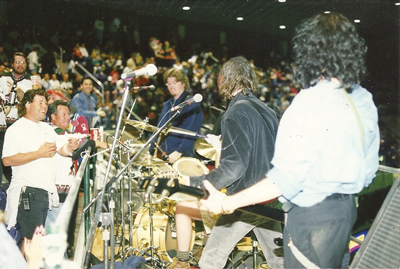 |
The Coyotes turned the upper deck in the north end into a party, complete with bands.
Photo by: COURTESY OF TODD WALSH
|
Live music upstairs became a Dog House staple. In the late ’90s, KDKB filled a niche in the market by providing airplay for new bands playing the Mill Avenue music clubs in Tempe near Arizona State University. As a result, Walsh had connections and got some of those groups to perform during intermission on a makeshift stage in the upper deck, a rickety structure of scaffolding and wood, in exchange for custom Coyotes jerseys and game tickets.
Robin Wilson, front man for the Gin Blossoms, a Tempe band that hit it big nationally, played at the Dog House with the Gas Giants, a band he formed after the Gin Blossoms originally broke up in 1997.
“The live music scene was flourishing back then and we didn’t chase after name bands,” Walsh said. “That really wasn’t the bit. The local bands … were willing to play anywhere, anytime. Exposure was the name of the game. It became the place to be and people [sitting elsewhere] wondered what the hell was going on and started wandering up there. The bands would develop their own songs and chants for the games. It was an area of lunatics but it developed into this sort of esprit de corps.”
Over time, the party waned in the north end as more Coyotes fans became educated about hockey and no longer wanted to sit in those limited-view seats. Many upgraded to better seats. Meanwhile, team ownership started pushing to build a new arena in Scottsdale in the East Valley section of Phoenix, where 80 percent of Coyotes’ season-ticket holders lived. The project got shot down publicly and the team ended up moving to Glendale in the West Valley, and its struggles to fill the building there have been well-documented.
America West Arena, now Talking Stick Resort Arena, remains the home of the Phoenix Suns and Mercury, along with indoor football’s Arizona Rattlers, but doesn’t have a hockey tenant.
For the Coyotes’ old ticket sales group, though, there are plenty of fond memories and lessons learned. “Under the leadership of Brenda Tinnen and Shawn Hunter … there was a never-say-die attitude for selling seats where you can’t see the game,” Willits said. “The message was find a way to make it happen.”
Tinnen’s three-year stint with the Coyotes is an experience she cherishes and wouldn’t trade for anything. “I still believe there is no bad seat in any venue,” she said. “You make do the best you can. It takes imagination and commitment.”






